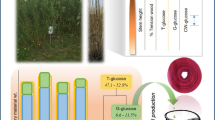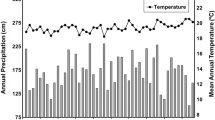Abstract
Postharvest residues for southern pine species have not previously been quantified to compare volumes produced from both thinnings and clearcut volumes. A John Deere 1490 Slash Bundler bundled postharvest residues following a first thinning of a 14-year-old stand, a second thinning of a 25-year-old stand, and a clearcut of a naturally regenerated mature stand of 54 years of age. Regardless of stand type, nearly one-fifth of merchantable volume harvested was collected as postharvest residue. Initial bundle moisture contents were 127.3, 81.1, and 49.4% dry basis (db) for the first and second thinnings and mature stands, respectively. Bundle needles content was found to significantly influence the relative moisture contents of the bundles by stand type due to the high moisture content of needles compared to other bundle components. Bundles were stored outside and exposed to very hot and dry conditions and dried very rapidly to lowest moisture contents of 22.8, 14.5, and 13.5% (db) for first and second thinnings and mature stands, respectively. Response to moderating temperatures and higher precipitation resulted in rapid moisture content increase to 69.9, 46.2, and 38.1% (db) for the first and second thinnings and mature stand bundles by the end of the study. Temperature and precipitation and bundle percentage needles content all significantly influenced the rapid moisture content variations observed over the study periods.







Similar content being viewed by others
References
Nettles, W. R. (2001). Improving the utilization of logging residues. Thesis, Department of Forestry, Mississippi State University, Mississippi State, MS.
Beardsell, M. G. (1983). Integrated harvesting systems to incorporate the recovery of logging residues with the harvesting of conventional forest products. Thesis, Department of Forestry. Virginia Polytechnic Institute and State University, Blacksburg, VA.
Watson, W. F., Stokes, B. J., & Savelle, I. W. (1986). Comparisons of two methods of harvesting biomass for energy. Forest Products Journal, 36(4), 63–68.
Mattson, J. A., & Carpenter, E. M. (1976). Logging residue in a northern hardwood timber sale. Northern Logger and Timber Processor, 24(9), 16–29.
Zobel, B. J., & Sprague, J. R. (1998). Juvenile wood in forest trees. Berlin: Springer-Verlag.
Koch, P. (1972). Utilization of the southern pines, vol. 1. USDA Forest Service, So. For. Expt. Sta., US Govt. Printing Office, Wash., DC.
Rummer, B., Len D., & O’Brien, O. (2004). Forest residues bundling project: New technology for residue removal. USDA Forest Service Forest Operations Unit, Southern Research Station CD Unnumbered Report.
Earl, J. A. (2006). Slash bundler performance in southeastern Arkansas. Thesis, Department of Forest Resources, University of Arkansas, Monticello, AR.
Acknowledgements
This project would not have been possible without the cooperation of the Potlatch timberlands staff. We are particularly indebted to Matt Roberts, Potlatch Production Engineer, for coordinating the study on the Potlatch harvest sites. We are also grateful for the financial support of John Deere, who supplied the 1490 Slash Bundler at no cost to the project. This study was funded by the DOE Strategic Biomass Initiative funds administered by Mississippi Technology Alliance, Jackson, MS. This manuscript is publication # FP410-0407 of the Forest and Wildlife Research Center, Mississippi State University.
Author information
Authors and Affiliations
Corresponding author
Rights and permissions
About this article
Cite this article
Steele, P.H., Mitchell, B.K., Cooper, J.E. et al. Bundled Slash: A Potential New Biomass Resource for Fuels and Chemicals. Appl Biochem Biotechnol 148, 1–13 (2008). https://doi.org/10.1007/s12010-007-8117-8
Received:
Accepted:
Published:
Issue Date:
DOI: https://doi.org/10.1007/s12010-007-8117-8




